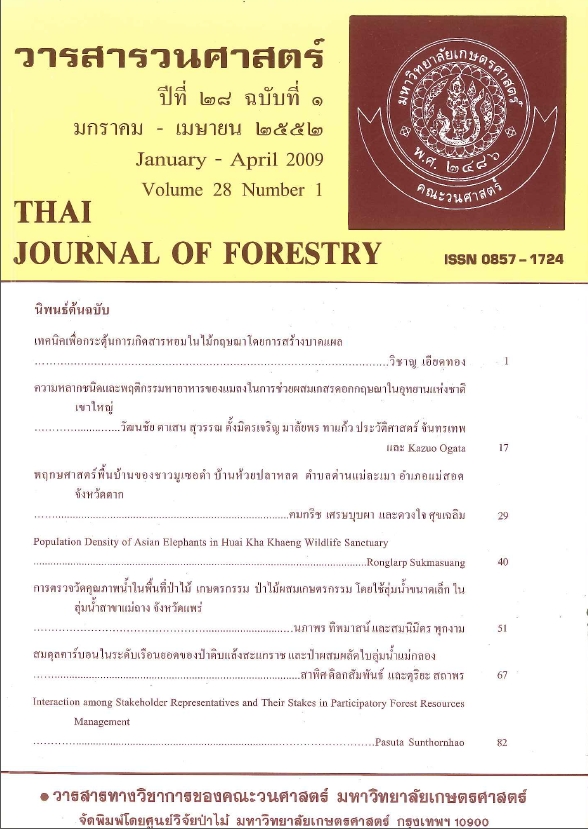Interaction among Stakeholder Representatives and Their Stakes in Participatory Forest Resources Management
Main Article Content
บทคัดย่อ
A study on the selection of stakeholder representatives for participatory forest resource management (PFRM) and their stake interaction was carried out during 2007 in the Huai Dau watershed (HDW) in Roi Et province, northeast Thailand. The HDW represented a land-use system unit, which combined agricultural and forestry activities. The research objectives were to determine and identify the major stakeholders (MaSTs) in PFRM who were in charge of stakeholder representation. The methodology began with a consideration of the biophysical, socio-economic and institutional situation. Data gathering and analysis were carried out in order to classify households and categorize stakeholders employing a partial process of participatory landscape lifescape appraisal (PLLA). Stakeholder analysis was based on the determination and identification of MaSTs who were the decision makers in PFRM based on four criteria: number of stakes (NS), duration of stakeholding (DS), degree of dependency (DD) and degree of accountability (DA). Moreover, the final analysis of interaction between stakeholders and stakes ranked the stakes based on the frequency of whole stakes. The study found eight MaSTs from the twelve stakeholders; two were individual stakeholders (ISTs), from a resident business (RB) and resident farm (RFa), while the other six were organization/institutional stakeholders (OSTs), being government organizations - forestry office (GOs-FO), government organizations - school (GOs-S), local government units - subdistrict administrative organization (LGUs-SAO), local government units - subdistrict leading office (LGUs-SLO), local government units - village leading office (LGUs-VLO) and people organizations - arts and craft center (POs-AC). The GOs-S was a highly effective MaST because this stakeholder achieved the highest total weighted mean score (TWMS). In addition, water was the most common stake followed by abundant soil, amenity, fuelwood and non wood forest products (NWFPs).
Keywords: participatory forest resources management, stakeholder analysis, major stakeholder, decision maker, participatory landscape lifescape appraisal
Downloads
Article Details

อนุญาตภายใต้เงื่อนไข Creative Commons Attribution-NonCommercial-NoDerivatives 4.0 International License.
ข้าพเจ้าและผู้เขียนร่วม (ถ้ามี) ขอรับรองว่า ต้นฉบับที่เสนอมานี้ยังไม่เคยได้รับการตีพิมพ์และไม่ได้อยู่ในระหว่างกระบวนการพิจารณาตีพิมพ์ลงในวารสารหรือสิ่งตีพิมพ์อื่นใด ข้าพเจ้าและผู้เขียนร่วม (ถ้ามี) ยอมรับหลักเกณฑ์และเงื่อนไขการพิจารณาต้นฉบับ ทั้งยินยอมให้กองบรรณาธิการมีสิทธิ์พิจารณาและตรวจแก้ต้นฉบับได้ตามที่เห็นสมควร พร้อมนี้ขอมอบลิขสิทธิ์ผลงานที่ได้รับการตีพิมพ์ให้แก่วารสารวนศาสตร์ คณะวนศาสตร์ มหาวิทยาลัยเกษตรศาสตร์ กรณีมีการฟ้องร้องเรื่องการละเมิดลิขสิทธิ์เกี่ยวกับภาพ กราฟ ข้อความส่วนใดส่วนหนึ่ง หรือ ข้อคิดเห็นที่ปรากฏในผลงาน ให้เป็นความรับผิดชอบของข้าพเจ้าและผู้เขียนร่วม (ถ้ามี) แต่เพียงฝ่ายเดียว และหากข้าพเจ้าและผู้เขียนร่วม (ถ้ามี) ประสงค์ถอนบทความในระหว่างกระบวนการพิจารณาของทางวารสาร ข้าพเจ้าและผู้เขียนร่วม (ถ้ามี) ยินดีรับผิดชอบค่าใช้จ่ายทั้งหมดที่เกิดขึ้นในกระบวนการพิจารณาบทความนั้น”


